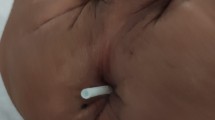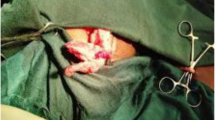Abstract
Ventriculo-peritoneal (VP) shunting used in the treatment for hydrocephalus is associated with several complications. Mechanical failure of shunt is the commonest complication of all. Visceral/bowel perforation is an unusual but serious complication of VP shunting. This article reports our experience in the management of ten children who had VP Shunt catheter protrusion from anus. This is a retrospective study of ten patients who had VP shunt catheter protrusion from anus, admitted in the department of paediatric surgery between Jan 1996 and Dec 2005. The records of above ten cases were reviewed for their clinical presentation and management, etc. We had performed 398 VP shunt operations in the last 10 years. Two hundred and seventy one (68.09%) VP Shunts were done for congenital hydrocephalus of which 164 were done in infancy/neonatal period and 107 VP shunts were done in the age group of >1–12 years. One hundred and twenty-seven (31.90%) VP shunt operations were done for patients who had hydrocephalus as a complication following tubercular meningitis (TBM). Out of 398 VP shunts, ten patients (2.51%) had protrusion of the distal end of peritoneal catheter from anus without causing/leading to peritonitis. We observed a 08.29% mortality of all VP shunt operations. Protrusion of VP shunt catheter per rectum can occur without producing peritonitis. Formal exploration and localization of entry of VP shunt catheter in bowel is not mandatory. Mini laparotomy and revision of peritoneal part of shunt can be done if there is no shunt infection.


Similar content being viewed by others
References
Lifshutz JI, Johnson WD (2001) History of hydrocephalus and its treatments. Neurosurg Focus 11:2:Article 1
Acharya R, Ramachandran CS, Singh S (2001) Laparoscopic management of abdominal complications in ventriculoperitoneal shunt surgery. J Lap Surg Tech 11:167–170
Gupta R (2003) Migrated ventriculo-peritoneal shunt in the inguinal hernial sac. Indian J Surg 65:186–187
Sharma AK, Pandey AK, Diyora BD, Mamidanna R., Sayal PP et al (2004) Abdominal CSF pseudocyst in a patient with ventriculo-peritoneal shunt. Indian J Surg 66:360–363
Sathyanarayana S, Wylen EL, Baskaya MK, Nanda A (2000) Spontaneous bowel perforation after ventriculoperitoneal shunt surgery: case report and a review of 45 cases. Surg Neurol 54:388–396
Surchev J, Georgiev K, Enchev Y, Avramov R (2002) Extremely rare complications in cerebrospinal fluid shunt operations. J Neurosurg Sci 46:100–103
Ansari S, Nejat F, Dadmehr M (2005) Extrusion of ventriculoperitoneal shunt catheter through the rectum & retrograde meningitis. Pediatr Inf Dis J 24:1027
Ferreira PR, Bizzi JJ, Amantea SL (2005) Protrusion of ventriculoperitoneal shunt catheter through the anal orifice—a rare abdominal complication. J Pediatr Surg 40:1509–1510
Warwick J Peacock (1998) Management of spina bifida, hydrocephalus, central nervous system infections, and intractable epilepsy, V edn. In: James A O’Neill, Marc I Rowe, Grosfeld Jay L et al (eds) Pediatric surgery. Mosby yearbook Inc, vol II, pp 1849–1858
Gupta DK, Dave S (2000) Hydrocephalus, test book of neonatal surgery. In: Gupta DK (ed) Modern Publishers, New Delhi, vol 1, pp 434–450
Guillen A, Costa JM, Castello I, Claramunt E et al (2002) Unusual abdominal complication of ventriculoperitoneal shunt. Neurocirugia (Astur) 13:401–404
Kumar R, Singh V, Kumar MV (2005) Shunt revision in hydrocephalus. Indian J Pediatr 72:843–847
Salomao JF, Leibinger RD (1999) Abdominal pseudocysts complicating CSF shunting in infants and children: Report of 18 cases. Pediatr Neurosurg 31:274–278
Oh A, Wildbrett P, Golub R, Yu LM et al (2001) Laparoscopic repositioning of a ventriculoperitoneal catheter tip for a sterile abdominal cerebrospinal fluid (CSF) pseudocyst. Surg Endosc 15:518
Jain S, Bhandarkar D, Shah R, Vengsarkar U (2003) Laparoscopic management of complicated ventriculoperitoneal shunts. Neurol India 51:269–270
Handa R, Harjai MM, Kale R (2005) Laparoscopic management of CSF pseudocyst abdomen. J Indian Assoc Pediatr Surg 10:95–96
Coley BD, Shiels WE 2nd, Elton S, Murakami JW, Hogan MJ (2004) Sonographically guided aspiration of cerebrospinal fluid pseudocysts in children and adolescents. Am J Roentgenol 183:1507–1510
Chidambaram B, Balasubramaniam V (2000) CSF ascites: a rare complication of ventriculoperitoneal shunts surgery. Neurol India 48:378–380
Morello FP (1997) Radiological quiz—complications of ventriculoperitoneal shunts. The child’s doctor (Journal of Children’s Memorial Hospital Chicago) fall 1997
Ueda Y, Kakino S, Hashimoto O, Imoto K (1998) Perforation of the bladder by a peritoneal catheter: an unusual late complication of ventriculo-peritoneal shunt. No Shinkei Geka 26:413–416
Wani AA, Ramzan A, Wani MA (2002) Protrusion of a peritoneal catheter through the umbilicus: an unusual complication of a ventriculoperitoneal shunt. Pediatr Surg Int 18:171–172
Nourisamie K, Vyas P, Swanson KF (2001) Two unusual complications of ventriculoperitoneal shunts in the same infant. Pediatr Radiol 31:814–816
Chan Y, Datta NN, Chan KY, Rehman SU et al (2003) Extrusion of the peritoneal catheter of a VP shunt system through a gastrostomy wound. Surg Neurol 60:68–70
Park CK, Wang KC, Seo JK, Cho BK (2000) Transoral protrusion of a peritoneal catheter: a case report and literature review. Childs Nerv Syst 16:184–189
Tamburrini G, Caldarelli M, Di Rocco C (2002) Diagnosis and management of shunt complications in the treatment of childhood hydrocephalus. Rev Neurosurgy, vol 1, p3 (electronic version)
Oemus K, Gerlach H, Rath FW (1992) A rare complication of shunt therapy: Metastasis of brain tumors by cerebrospinal fluid drainage. Zentralbl Neurochir 53:25–32
Rickert CH (1998) Abdominal metastases of pediatric brain tumors via ventriculoperitoneal shunts. Childs Nerv Syst 14:10–14
Yilmaz N, Krymaz N, Yilmaz C, Caksen H et al (2004) Anal protrusion of ventriculo-peritoneal shunt catheter: report of two infants. J Pediatr Neurol 2:241–244
Chen HS (2000) Rectal penetration by a disconnected ventriculoperitoneal shunt tube: an unusual complication. Chang Gung Med J 23:180–184
Sharma A, Pandey AK, Radhakrishnan M, Kumbhani D et al (2003) Endoscopic management of anal protrusion of ventriculo-peritoneal shunt. Indian J Gastroenterol 22:29–30
Yadav YR, Pande S, Raina VK, Singh M (2004) Lumboperitoneal shunts: Review of 409 cases. Neurol India 52:188–190
Melikian AG, Shakhnovich AR, Arutiunov NV (2002) Results of endoscopic ventriculostomy of the III ventricle in the treatment of occlusive hydrocephalus (Article in Russian) Zh Vopr Neirokhir Im N N Burdenko 4:5–11
Ray P, Jallo GI, Kim RYH, Kim BS, Wilson S et al (2005) Endoscopic third ventriculostomy for tumor related hydrocephalus in a pediatric population Neurosurg Focus 19(6):E8
Grover S, Menon P, Samujh R, Rao KLN (2004) Congenital hydrocephalus: A comparative study on the efficacy and complications after low versus medium pressure ventriculoperitoneal shunts. J Indian Assoc Pediatr Surg 9:143–147
Couldwell WT, LeMay DR, McComb JG (1996) Experience with use of extended length peritoneal shunt catheters, J Neurosurg 85:425–427
Author information
Authors and Affiliations
Corresponding author
Rights and permissions
About this article
Cite this article
Ghritlaharey, R.K., Budhwani, K.S., Shrivastava, D.K. et al. Trans-anal protrusion of ventriculo-peritoneal shunt catheter with silent bowel perforation: report of ten cases in children. Pediatr Surg Int 23, 575–580 (2007). https://doi.org/10.1007/s00383-007-1916-8
Accepted:
Published:
Issue Date:
DOI: https://doi.org/10.1007/s00383-007-1916-8




